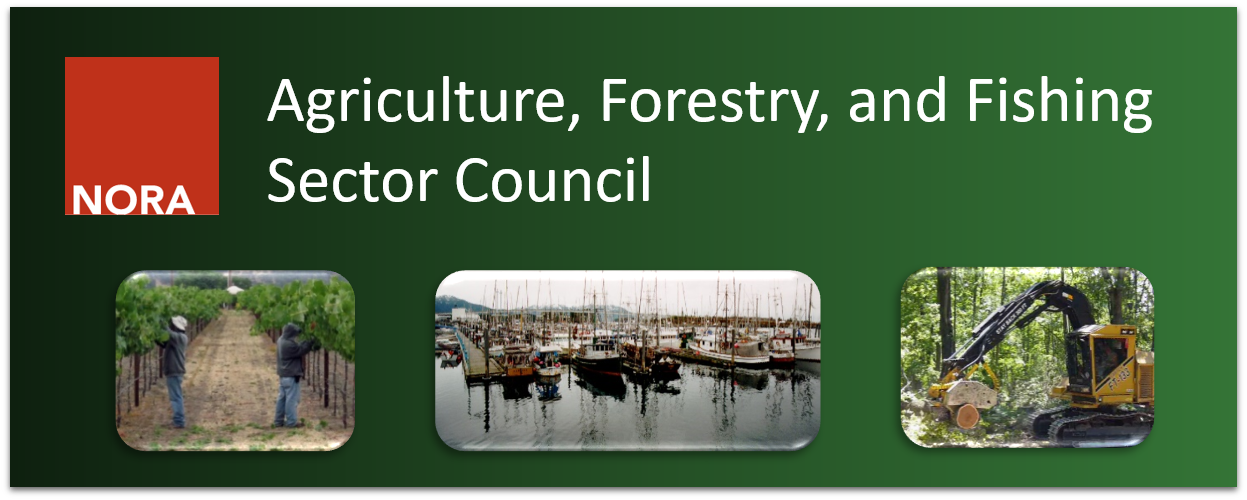NORA Agriculture, Forestry and Fishing Sector Council

The NORA Agriculture, Forestry and Fishing (AgFF) Council brings together individuals and organizations with a shared interest in improving the safety and health of agriculture, forestry, and fishing workers. AgFF Council members share information, form partnerships, and promote adoption and dissemination of solutions that work. Contact the council co-chair or NORA Coordinator to volunteer.
The NORA Agriculture, Forestry, and Fishing Council, in collaboration with partners across the country, released The Fishing Forward Podcast. This podcast series focuses on health, safety, and “staying shipshape” in the commercial fishing industry. It features conversations with both scientific experts and fishermen as they explore topics such as sleep deprivation, diet and nutrition, injury prevention, and much more. The Fishing Forward Podcast is available on most podcast streaming platforms and at www.coastalroutes.org/fishingforwardpod. All 18 episodes are available now.
The NORA AgFF Sector Council identified research priorities for the third decade of NORA (2016-2026) in the National Occupational Research Agenda for AgFF. The agenda identifies 13 research objectives for the nation.
Research objectives for the nation:
Agriculture
- AG-01:Reduce risk of fatal and nonfatal injuries to workers in the agriculture sub-sector.
- AG-02:Reduce the risk of work-related illnesses to workers in the agriculture sub-sector.
- AG-03:Improve reporting and surveillance of injury and illness in the agriculture sub-sector.
- AG-04:Reduce the risk of illnesses and injuries in vulnerable worker populations in the agriculture sub-sector.
Forestry
- FO-01:Reduce the risk of fatal and non-fatal injuries to workers in the forestry sub-sector.
- FO-02:Reduce the risk of work-related illness to workers in the forestry sub-sector.
- FO-03:Increase data meshing, information sharing, and collaboration among researchers in the forestry sub-sector.
- FO-04:Reduce injuries and illness in vulnerable worker populations in the forestry sub-sector.
Fishing
- FI-01:Reduce the risk of fatal and non-fatal injuries in the commercial fishing sub-sector.
- FI-02:Reduce the risk of work-related illness to workers in the commercial fishing sub-sector.
- FI-03:Increase safety & health data meshing, information sharing, & collaboration among fishing safety researchers for workers in the fishing sub-sector.
- FI-04:Reduce injuries and illness in the vulnerable worker populations in the fishing sub-sector.
- FI-05:Reduce the risk of illnesses and injuries in the seafood processing industry.
The Agriculture, Forestry, and Fishing sector has approximately 2.3 million workers and includes all jobs under North American Industry Classification System (NAICS) code 11. Agriculture includes crop production, animal production and aquaculture. These workers plant and harvest a wide variety of crops; tend livestock on cattle ranches, pig farms, and dairy farms; and produce eggs and chickens. The forestry industry includes logging operations and businesses that grow trees and gather forest products. Fishing includes a variety of commercial fishing operations. Together, these industries play a critical role in providing food, fuel, and fiber for the United States and around the globe. However, they are also one of the most hazardous industrial sectors, with the a high fatal occupational injury rate. Traumatic injuries are prevalent in all three industries, although the specific causes vary. Many workers in agriculture, forestry and fishing are also at greater risk for a variety of health and safety issues because social and economic factors can limit their options for safeguarding their own safety and health.
The NIOSH Agriculture, Forestry and Fishing Program facilitates the work of the council and coordinates NIOSH research in this sector.